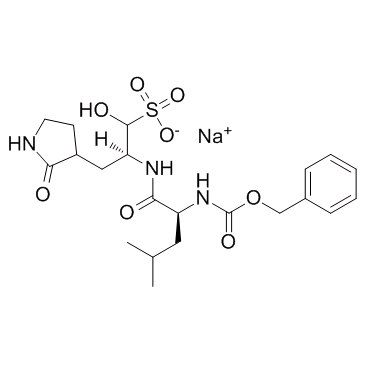| Reference | 1. J Feline Med Surg. 2017 Sep 1:1098612X17729626. doi: 10.1177/1098612X17729626.
[Epub ahead of print] <br />
<br />
Efficacy of a 3C-like protease inhibitor in treating various forms of acquired
feline infectious peritonitis. <br />
<br />
Objectives The safety and efficacy of the 3C-like protease inhibitor GC376 was
tested on a cohort of client-owned cats with various forms of feline infectious
peritonitis (FIP). Methods Twenty cats from 3.3-82 months of age (mean 10.4
months) with various forms of FIP were accepted into a field trial. Fourteen cats
presented with wet or dry-to-wet FIP and six cats presented with dry FIP. GC376
was administered subcutaneously every 12 h at a dose of 15 mg/kg. Cats with
neurologic signs were excluded from the study. Results Nineteen of 20 cats
treated with GC376 regained outward health within 2 weeks of initial treatment.
However, disease signs recurred 1-7 weeks after primary treatment and relapses
and new cases were ultimately treated for a minimum of 12 weeks. Relapses no
longer responsive to treatment occurred in 13 of these 19 cats within 1-7 weeks
of initial or repeat treatment(s). Severe neurologic disease occurred in 8/13
cats that failed treatment and five cats had recurrences of abdominal lesions. At
the time of writing, seven cats were in disease remission. Five kittens aged
3.3-4.4 months with wet FIP were treated for 12 weeks and have been in disease
remission after stopping treatment and at the time of writing for 5-14 months
(mean 11.2 months). A sixth kitten was in remission for 10 weeks after 12 weeks
of treatment, relapsed and is responding to a second round of GC376. The seventh
was a 6.8-year-old cat with only mesenteric lymph node involvement that went into
remission after three relapses that required progressively longer repeat
treatments over a 10 month period. Side effects of treatment included transient
stinging upon injection and occasional foci of subcutaneous fibrosis and hair
loss. There was retarded development and abnormal eruption of permanent teeth in
cats treated before 16-18 weeks of age. Conclusions and relevance GC376 showed
promise in treating cats with certain presentations of FIP and has opened the
door to targeted antiviral drug therapy. <br />
<br />
2. Virus Res. 2013 Dec 26;178(2):437-44. doi: 10.1016/j.virusres.2013.09.008. Epub
2013 Sep 17. <br />
<br />
Structural and inhibitor studies of norovirus 3C-like proteases. <br />
<br />
Noroviruses have a single-stranded, positive sense 7-8kb RNA genome, which
encodes a polyprotein precursor processed by a virus-encoded 3C-like cysteine
protease (3CLpro) to generate mature non-structural proteins. Because processing
of the polyprotein is essential for virus replication, norovirus 3CLpro has been
targeted for the discovery of anti-norovirus small molecule therapeutics. Thus,
we performed functional, structural and inhibition studies of norovirus 3CLpro
with fluorescence resonance energy transfer (FRET) assay, X-ray crystallography,
and NMR spectroscopy with a synthetic protease inhibitor. Three 3CLpro from
Norwalk virus (NV, genogroup I), MD145 (genogroup II) and murine norovirus-1
(MNV-1, genogroup V) were optimized for a FRET assay, and compared for the
inhibitory activities of a synthetic protease inhibitor (GC376). The apo 3D
structures of NV 3CLpro determined with X-ray crystallography and NMR
spectroscopy were further analyzed. In addition, the binding mode of NV
3CLpro-GC376 was compared with X-ray crystallography and NMR spectroscopy. The
results of this report provide insight into the interaction of NV 3CLpro with
substrate/inhibitor for better understanding of the enzyme and antiviral drug
development. <br />
<br />
3. J Virol. 2012 Nov;86(21):11754-62. doi: 10.1128/JVI.01348-12. Epub 2012 Aug 22. <br />
<br />
Broad-spectrum antivirals against 3C or 3C-like proteases of picornaviruses,
noroviruses, and coronaviruses. <br />
<br />
Phylogenetic analysis has demonstrated that some positive-sense RNA viruses can
be classified into the picornavirus-like supercluster, which includes
picornaviruses, caliciviruses, and coronaviruses. These viruses possess 3C or
3C-like proteases (3Cpro or 3CLpro, respectively), which contain a typical
chymotrypsin-like fold and a catalytic triad (or dyad) with a Cys residue as a
nucleophile. The conserved key sites of 3Cpro or 3CLpro may serve as attractive
targets for the design of broad-spectrum antivirals for multiple viruses in the
supercluster. We previously reported the structure-based design and synthesis of
potent protease inhibitors of Norwalk virus (NV), a member of the Caliciviridae
family. We report herein the broad-spectrum antiviral activities of three
compounds possessing a common dipeptidyl residue with different warheads, i.e.,
an aldehyde (GC373), a bisulfite adduct (GC376), and an α-ketoamide (GC375),
against viruses that belong to the supercluster. All compounds were highly
effective against the majority of tested viruses, with half-maximal inhibitory
concentrations in the high nanomolar or low micromolar range in enzyme- and/or
cell-based assays and with high therapeutic indices. We also report the
high-resolution X-ray cocrystal structures of NV 3CLpro-, poliovirus 3Cpro-, and
transmissible gastroenteritis virus 3CLpro- GC376 inhibitor complexes, which show
the compound covalently bound to a nucleophilic Cys residue in the catalytic site
of the corresponding protease. We conclude that these compounds have the
potential to be developed as antiviral therapeutics aimed at a single virus or
multiple viruses in the picornavirus-like supercluster by targeting 3Cpro or
3CLpro. <br />
|

